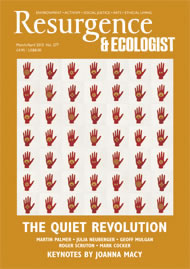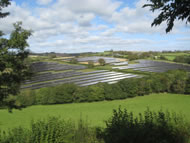At a time of increasing climatic uncertainty, and amidst warnings from Oxfam, Stockholm International Water Institute and the World Bank that world food prices are undergoing another ‘spike’ like that of 2008, it surely makes sense that agricultural land everywhere should be used to produce food, and not to generate electricity. But in the far south-west of Britain this is exactly what is happening, with farmers and developers scrambling to install solar photovoltaic (SPV) arrays and wind turbines all across Cornwall.
The East Looe Valley Energy Network (ELVEN) – a community group established to give local residents a say in the process of planning applications for numerous solar farms – has identified over 200 SPV screening applications for Cornwall. These are mostly located in officially designated Areas of Outstanding Natural Beauty, or Areas of Great Landscape Value. Many are located on the best agricultural land, in what is essentially a process of industrialisation of the countryside. A recent fall in the price of photovoltaic cells – manufactured mainly in China – means that, despite last year’s UK government reduction of the Feed-in Tariff for solar electricity supplied to the national grid, many applications formerly abandoned or shelved are now profitable.
The new National Planning Policy Framework, with its “presumption in favour of sustainable development”, “ensuring that the planning system does … not act as an impediment”, has been taken by some as a green light. In part of East Cornwall, a 13-hectare plot with more than 25,000 photovoltaic panels has been approved, while next door another developer has applied for a 7.5-hectare plot with another 22,000 panels.
ELVEN is not against solar power or wind energy per se, but opposes approval of their installation on an industrial scale and on the best agricultural land via a county planning strategy that sees alternative energy provision mainly in terms of business opportunities. Instead, ELVEN suggests that solar energy be generated not on farmland but on large buildings – not just council premises but also factories, barns, schools, colleges, shops and especially supermarkets, as well as domestic dwellings. Wind turbines and SPVs should be installed only on the poorest land (brownfield sites) and not the best farmland.
Some objectors also oppose installation by commercial developers, and would prefer wind turbines built by local communities. At Gorran High Lanes near Mevagissey, in mid Cornwall, two community wind turbines have now been operating for a year. Revenues are fed back into the local community, not into the pockets of developers.
People also fear the effects of potentially divisive planning applications on morale in small communities. Experience of past controversies suggests that these may suffer: my own village has not really recovered from the last such episode, 15 years ago.
Despite the formal existence of local democracy, there are no real avenues via which to express opposition. Planners ignore parish councillors’ objections, and no local forums exist in which issues that cut across parishes can be discussed. Consequently, ELVEN is hoping to establish a network for its own part of Cornwall, and to reach out to groups in other parts of Cornwall, in order to press for a moratorium on all new approvals of wind farms and SPVs on greenfield sites until a more rational policy under more local democratic control is introduced.
For the first decade of the 2000s, UK policy maintained that Britain did not need to feed itself but could rely instead on imports. In 2010, however, in response to the 2008 ‘food spike’, the Department for Food and Rural Affairs reversed its policy and committed the nation to producing as much food as possible, a strategy the subsequent coalition government has maintained. Approving wind farms and SPV arrays on agricultural land is not consistent with this policy. It is really the commitment of successive secretaries of state for energy to ‘keeping the lights on’ that is driving current industrialisation of the countryside. Little attention has been paid to reducing demand, and few, if any, politicians ever seem to reflect that there are in fact ‘too many lights!’
Forty years ago, E.F. Schumacher published Small is Beautiful, the key text underlying the idea of alternative technology. Schumacher foresaw that a truly ecological society would need to develop a new and different kind of technology: inexpensive, ecologically benign, economically decentralising, and subject to local, democratic political control. Current energy developments portray themselves as ‘green’, but represent a travesty of alternative technology. They are not small, or in any sense beautiful: they produce electricity on an industrial scale and feed it into a national grid, not a local grid. In pursuit of a ‘green’ energy that is not really green at all, they also have severe adverse effects on local environments, local people and local communities. Schumacher, who believed in ‘benign’ technology, would no doubt have utterly repudiated such commercial pursuit of energy.








